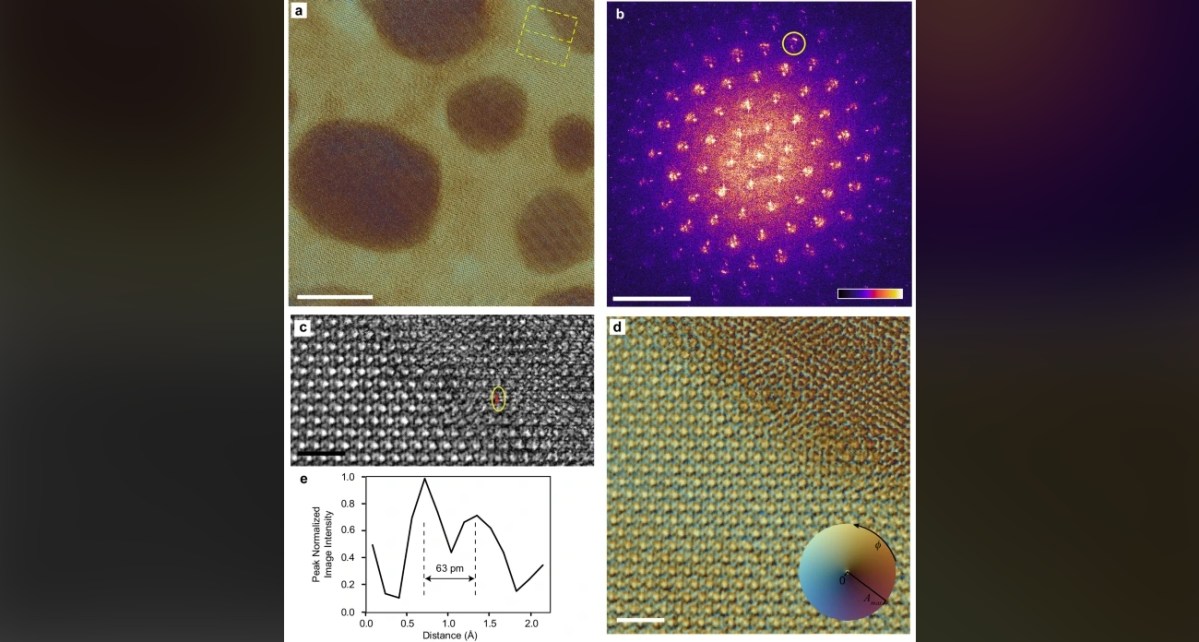Science
UVic Researchers Achieve Groundbreaking Electron Microscopy Breakthrough

Researchers at the University of Victoria have made a significant advancement in electron microscopy, achieving “sub-Ångström resolution” for the first time. This groundbreaking technique allows scientists to visualize atomic structures with precision exceeding one ten-billionth of a metre, utilizing a compact, low-energy scanning electron microscope (SEM). This development marks a pivotal moment in the field, as it enables high-resolution imaging without the need for the large and costly transmission electron microscopes (TEMs) traditionally used for such purposes.
Led by Arthur Blackburn, co-director of the university’s Advanced Microscopy Facility, the research team has demonstrated that a simpler SEM combined with advanced computational techniques can match or even exceed the resolution of more expensive alternatives. In Blackburn’s words, “This work shows that high-resolution imaging doesn’t have to rely on expensive, complex equipment.”
The findings were published on October 10, 2025, in the scientific journal Nature Communications, highlighting a major step toward making atomic-scale imaging more accessible to laboratories globally. This new method reduces costs, energy consumption, and space requirements, potentially accelerating innovation across various scientific disciplines.
Revolutionizing Atomic Imaging
At the core of this breakthrough lies a technique known as ptychography. It employs overlapping patterns of scattered electrons to reconstruct extraordinarily detailed images. The team achieved an impressive resolution of just 0.67 Ångström, which is smaller than a single atom and approximately 1/10,000th the width of a human hair, all while using a low-energy electron beam.
“This could be transformative for fields like materials science, nanotechnology, and structural biology,” Blackburn noted. The immediate implications of this advancement are particularly promising for the research and production of two-dimensional materials, which are crucial for developing next-generation electronics.
Looking ahead, Blackburn emphasized the potential for this discovery to aid in determining the structure of small proteins, which could ultimately enhance health and disease research.
The research collaboration also involved Hitachi High-Tech Canada and was supported by the Natural Sciences and Engineering Research Council of Canada, showcasing the collective effort to push the boundaries of scientific knowledge and technological capability in microscopy.
As the scientific community continues to explore the implications of this technique, the University of Victoria stands at the forefront of a revolution in how researchers can visualize and understand the atomic realm.
-

 Education3 months ago
Education3 months agoBrandon University’s Failed $5 Million Project Sparks Oversight Review
-

 Science4 months ago
Science4 months agoMicrosoft Confirms U.S. Law Overrules Canadian Data Sovereignty
-

 Lifestyle3 months ago
Lifestyle3 months agoWinnipeg Celebrates Culinary Creativity During Le Burger Week 2025
-

 Health4 months ago
Health4 months agoMontreal’s Groupe Marcelle Leads Canadian Cosmetic Industry Growth
-

 Technology3 months ago
Technology3 months agoDragon Ball: Sparking! Zero Launching on Switch and Switch 2 This November
-

 Science4 months ago
Science4 months agoTech Innovator Amandipp Singh Transforms Hiring for Disabled
-

 Education3 months ago
Education3 months agoRed River College Launches New Programs to Address Industry Needs
-

 Technology4 months ago
Technology4 months agoGoogle Pixel 10 Pro Fold Specs Unveiled Ahead of Launch
-

 Business3 months ago
Business3 months agoRocket Lab Reports Strong Q2 2025 Revenue Growth and Future Plans
-

 Technology2 months ago
Technology2 months agoDiscord Faces Serious Security Breach Affecting Millions
-

 Education3 months ago
Education3 months agoAlberta Teachers’ Strike: Potential Impacts on Students and Families
-

 Science3 months ago
Science3 months agoChina’s Wukong Spacesuit Sets New Standard for AI in Space
-

 Education3 months ago
Education3 months agoNew SĆIȺNEW̱ SṮEȽIṮḴEȽ Elementary Opens in Langford for 2025/2026 Year
-

 Technology4 months ago
Technology4 months agoWorld of Warcraft Players Buzz Over 19-Quest Bee Challenge
-

 Business4 months ago
Business4 months agoNew Estimates Reveal ChatGPT-5 Energy Use Could Soar
-

 Business3 months ago
Business3 months agoDawson City Residents Rally Around Buy Canadian Movement
-

 Technology2 months ago
Technology2 months agoHuawei MatePad 12X Redefines Tablet Experience for Professionals
-

 Business3 months ago
Business3 months agoBNA Brewing to Open New Bowling Alley in Downtown Penticton
-

 Technology4 months ago
Technology4 months agoFuture Entertainment Launches DDoD with Gameplay Trailer Showcase
-

 Technology4 months ago
Technology4 months agoGlobal Launch of Ragnarok M: Classic Set for September 3, 2025
-

 Technology4 months ago
Technology4 months agoInnovative 140W GaN Travel Adapter Combines Power and Convenience
-

 Science4 months ago
Science4 months agoXi Labs Innovates with New AI Operating System Set for 2025 Launch
-

 Top Stories2 months ago
Top Stories2 months agoBlue Jays Shift José Berríos to Bullpen Ahead of Playoffs
-

 Technology4 months ago
Technology4 months agoNew IDR01 Smart Ring Offers Advanced Sports Tracking for $169










